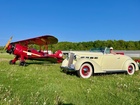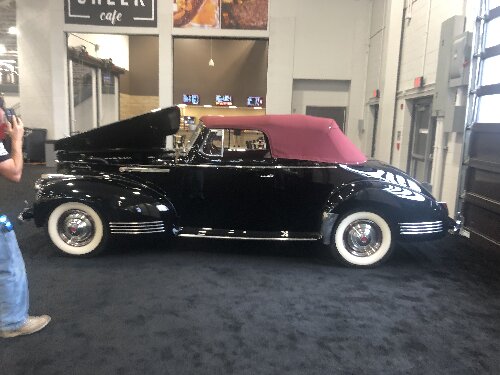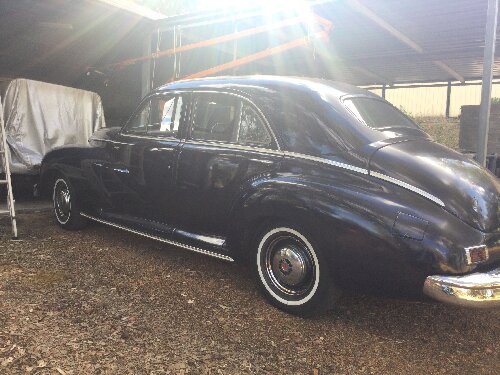|
Re: Gummed up carb never rebuilt a carb
|
||||
|---|---|---|---|---|
|
Home away from home
|
Johntrhodes81
I also vote with Jim/KB1MCV, 'jump right in to the deep end'. I started working on WCFBs, two at a time, some 50 years ago when I had a set on a '55 Chevy, and then fast forward to the single set-up on my '54 Cavalier. I would like to provide some suggestions based on my experiences. Let's start by assuming there was nothing really 'wrong' with the carburetor when the car slipped into hibernation, and the task is to renew parts that do not hibernate well like rubber and leather parts. Plus there's the goal of cleaning the unit both inside and out. I suggest/recommend: 1. Resist the urge to remove the throttle plates. Unless the throttle shaft has been abused or requires bushings there is more risk than reward in removing throttle plates. 2. As BigKev suggested disassemble the carburetor in a clean pan. I use a transmission oil pan, but only because I have one. A turkey pan from the grocery store will work just fine, or as suggested a cookie sheet, but later on when you're in the cleaning stage a pan with some depth will be an advantage. 3. Place the parts as you remove them into individual containers. I use tuna fish cans for the small screws and clips, and larger ones for the other 'stuff'. Watch those little hair clips they have been known to take flight during installation. Use a hemostat or needle nose pliers to hold-on to those clips. 4. Make sure you keep the primary and secondary parts in separate containers. The jets are different, so don't mingle them. 5. Do NOT invert the carburetor until the all of the springs and check balls are accounted for. There should be two check devices in the accelerator pump system. A ball and the bottom of the well, and a needle under the discharge nozzle. There a springs at the 'vacuumeter' and accelerator pump. The first time the carburetor body is inverted it should be done over a clean pan. 6. Lacquer thinner is a fairly good solvent for carburetor cleaning, and it's available at relatively low cost. I use a 'tinners brush' to wash the parts with solvent, and change the solvent when it gets real dirty. 7. Fuel 'shut-off' valves are currently available in two design configurations. The 'Daytona' kits will likely come with the 'flat disk' design valve. With this design the float level adjustment is via 'extra' sealing washers between the valve and carburetor housing (described in the instructions). The other valve design ( historically correct for a WCFB ) features a conic 'needle', as in needle and seat, and the float level adjustment is via bending the tang that closes the needle. The 'flat disk' design is not robust to side forces and therefore the tang on the floats should 'push' dead center on the valve. That's why the seats are shimmed with sealing washers. Again all of this is covered in the instructions if your kit has 'flat disk' valves. 8. I use a piece of cardboard holding a jet or air bleed in-place. I then hold the whole mess up to the sun or bright light bulb (cardboard shielding my eyes) and look up the bore of the jet/air bleed. You will be amazed on what you can see with only the small 'pin prick' of light shining through the orifice. If you can't see light, or the light is fussy, then the 'thing' must be cleaned. 9. Knowing from the specification sheets what the 'correct' diameter of the orifice is, I will use a number drill SMALLER than the specification diameter to clean-out the 'gunk'. Don't use a drill that is larger than the specified diameter. For about $10 you can buy a set of drills, numbers 61 to 80, on the internet. That size range will suit your needs. 10. Compressed air can be used to verify that large drilled passages are clear. You may not need to remove any of the aluminum plugs that seal the cross drilled passages. If the passages are sealed with threaded plugs feel free to remove them. 11. The carburetor kits that were available back in the '50 -'60s came with float level gauges . . . not so much today. I use a drill of the correct diameter to verify the float level adjustment. 12. Re-installing the metering rods can be a bit finicky in that the spring tends to push the rods out of alignment with the jet bores Take your time they do fit. Other than 'take a lot of photos', that all I've got. DP
Posted on: 2020/1/4 13:58
|
|||
|
||||
|
Re: Door Handle Retainer
|
||||
|---|---|---|---|---|
|
Home away from home
|
So I guess we're waiting for Dan W to report back whether the handle/shaft has pulled out of the escutcheon, or the whole kit and caboodle has come out as a result of the screw falling out.
Merry Christmas to all.
Posted on: 2019/12/24 18:05
|
|||
|
||||
|
Re: Door Handle Retainer
|
||||
|---|---|---|---|---|
|
Home away from home
|
If the '41 door handle is similar to the '48 trunk handle (apparently many others) then the handle assembly is comprised of a handle, escutcheon, square shaft, and a locking collar. It is the locking collar that simultaneously attaches the square shaft to the outside handle, and keeps the handle from pulling out of the escutcheon. It is the escutcheon that is affixed to the door skin with machine screws.
Now the question is whether the '41 door handle is similar to the '48 trunk handle in design, and if it is the technique I used to fix my '48 trunk handle/latch perhaps could be used to repair the '41 handle. Dan W. here's a link to the fix for the '48 trunk handle/latch. If it looks like a viable fix please let us know for future reference. Post #12 from HH56 may depict what has happened (again assumes the designs are similar). Post #15 from BDeB shows the assembly and the escutcheon and 'thimble' ('41 versus '48 disclaimer). https://packardinfo.com/xoops/html/modules/newbb/viewtopic.php?topic_id=17428&viewmode=flat&order=ASC&type=&mode=0&start=0 dp
Posted on: 2019/12/24 16:50
|
|||
|
||||
|
Re: Airplanes - Engines - Aircraft Testing Field
|
||||
|---|---|---|---|---|
|
Home away from home
|
Chris.
The primary use of the Liberty was in aircraft. ? American-built versions of the Airco DH.4 ? Airco DH.9A ? Airco DH.10 ? Breguet 14 B2 L ? Caproni Ca.60 ? Curtiss H-16 ? Curtiss HS ? Curtiss NC ? Curtiss Carrier Pigeon ? Douglas C-1 ? Douglas DT ? Douglas O-2 ? Felixstowe F5L ? Fokker T.II ? Handley Page H.P.20 ? Witteman-Lewis XNBL The engine was also used in the RN-1 (Zodiac) blimp. With more rugged barrels the Liberty V-12 was slated for track vehicle (tank) use. Only 100 of these tanks were manufactured, but too late for WWI. According to Wikipedia 20,748 units were built. Manufactures included Lincoln, Ford, Packard, Marmon, and Buick. During WWII, Neffield, a UK car manufacture produced Liberty engines under license, for various UK tanks. It was not at all uncommon for aircraft engines to be pressed into service powering track vehicles. Many M-2, M-3 Lee, M-4 Sherman, and M7 Priest's were powered by Continental produced Wright R975s . . . along with hosts of low production, or field modified chassis. dp
Posted on: 2019/11/30 18:23
|
|||
|
||||
|
Re: Coil wiring question
|
||||
|---|---|---|---|---|
|
Home away from home
|
Just a few more points on this 6 volt positive ground Pertronix stuff:
If the subject car is equipped with an overdrive (not the case in this thread) there will likely be two wires attached to the positive coil binding post. One wire goes to the ignition point set, while the other goes to the overdrive kick-down switch. When I contacted Pertronix about how the kick-down functionality could be retained they provided the attached schematic . . . essentially a 7 ohm, 5 watt resistor in series with the kick-down circuit. If the car is currently AutoLite equipped, and a Pertronix coil is used, then the installer must provide a coil hold-down strap. Seems the Delco equipped cars used a 'bare' coil, just like the Pertronix replacement items, while the AutoLite coil had an integral coil clamp. See group 4.12033 in the parts book, and note the strap is only used on Delco equipped vehicles. Not a big deal to make one out of sheet stock, just be aware that 'some assembly is required' on AutoLite equipped cars. dp
Posted on: 2019/11/19 21:01
|
|||
|
||||
|
Re: Limited File Size On The Packard Club Website
|
||||
|---|---|---|---|---|
|
Home away from home
|
At a Model A monthly club meeting a gentleman that creates these 'light paintings' gave a presentation on the process. To boil a 20 minute presentation down to a few bullet points . . .
? The scene is set when there is adequate ambient light. ? The photo sequence is created when there is little or no ambient light. ? A camera is placed in a fixed position, that is, on a substantial tripod. ? The camera is adjusted for a smaller than normal aperture, and longer than normal shutter speed. The shutter is triggered remotely. ? Multiple photos are taken, and are digitally combined into one final image. ? Each one of the multiple photos is a time-lapse where one, and only one small area of the car is 'painted' with a portable light . . . hence 'light painting'. That photo will only contain the painted areas, while the rest of the scene is very dark. 'Light painting' photos will have a characteristic of the subject seems to be illuminated in every nook and cranny, with little or no areas in shadow. While the subject is well illuminated the background is quite dark. It takes a while to paint an object the size of a car. The gentleman suggested the 'stitching' of the multiple photos may be iterative, that is, the artist may reject incorporation of one or more of the photos if that content detracted from the final objective. The views of the '56 with the spiral white light accents are examples where the person holding the light walked through the frame with the light moving. The photo with this feature could be added to, or left-out of the final image. The photos with the white and blue spirals and the rear view of the car appear to have too few individual sub-photos. The ? front view would approach the desired final effect, although the shadows on the hood might have been filled in. Note a few of the photos were taken with only the interior illuminated. These might have been taken while the 'painter' was inside the car shinning the light onto the headliner, but they could be standing in the un-illuminated section of the photo. Equally, not all photos need to have the car's lights on . . . only enough to have illumination appear in that area of the photo. The 'painter' is normally dressed in dark clothing. I believe the final effect could be categorized as; the subject is presented in full light, while nothing in the background is illuminated. From what I understand these photos take an hour or so to 'capture', and some amount of time for the 'stitching' into a final image.
Posted on: 2019/10/25 21:35
|
|||
|
||||
|
Re: Door locks
|
||||
|---|---|---|---|---|
|
Home away from home
|
Let's try that link again. This is the pointer to the first item on the fifth page of the thread. Scroll down to the items with the PDF attachments . . . lots of photos of a latch disassembled, and suggestions on replacement of the rivets that will be destroyed.
https://packardinfo.com/xoops/html/modules/newbb/viewtopic.php?topic_id=19146&viewmode=flat&order=ASC&type=&mode=0&start=40 dp
Posted on: 2019/10/8 11:14
|
|||
|
||||
|
Re: Door locks
|
||||
|---|---|---|---|---|
|
Home away from home
|
If the discussion is about the replacement of the four lobed 'wheel' that engages the striker plate, then try the following postings.
https://packardinfo.com/xoops/html/modules/newbb/viewtopic.php?topic_id=19146&viewmode=flat&order=ASC&type=&mode=0&start=44 https://packardinfo.com/xoops/html/modules/newbb/viewtopic.php?topic_id=19146&viewmode=flat&order=ASC&type=&mode=0&start=46 I've edited the original posting to include 'http://' and seems to be the key in adding hyper-links. I've also edited the 'start number' to point to the correct posting. dp
Posted on: 2019/10/8 11:07
|
|||
|
||||
|
Re: 47 Rear Axle Nut Torque
|
||||
|---|---|---|---|---|
|
Home away from home
|
Wes;
When I torqued the axle nuts on my '48 I set-up a jack stand, the same height as the axle, to react out the vertical force of the wrench. I used an extension about 9 inches long, so the end where the breaker bar would be attached rested on the jack stand. The breaker bar was marked at the location where I would step on it with one foot to apply the torque. By use on a short kitchen step stool I was able to slowly transfer from the stool to the breaker bar . . . again only stepping on the marked area. During the process I had to reset the set-up several times to make sure the breaker bar was level . . . that is, my weight was being applied at right angles to the bar. I shot for the lowest torque on the first attempt, and at that torque the cotter pin hole was in alignment, so I stopped, but only after I hit the hub a couple of dozen times with a light ballpeen. The tapping did not result in a reduction of torque, so I was truly finished. About 200 miles later I 'double checked' the torque. What I found was that most of the torque had dissipated, and I could advance the nut about 1/6 of a turn. This time the cotter pin would not align at the lowest torque, but did at a torque less than the maximum allowed. 'Double checking' again after another 200 miles revealed the axle nut torque was at least the minimum allowed. There are some that think the relaxation of the nut torque is the mechanism that allows alternating bending stresses at the axle thread fillet which ultimately results in a broken axle. My experience suggests that the hub could be loose on the axle if the torqueing procedure is treated as a 'one and done' event. I do know that the reason I was torqueing the axle nut in the first place was the previous axle had failed shortly after I bought the car. I have no idea the miles since last axle service before I bought the car. Maybe rear axle nuts should be treated like head bolts (nuts) . . . that is, you're never done checking the torque. While I assembled with everything dry, I did try to 'scotch brite' the axle taper to something less than a bright shine, but clean of rust (fretting) and goo. I used a new grade 8 flat washer, as the one on the car was heavily galled. Even with a broken axle the key I removed was not heavily worn, and under normal circumstances I would have reused it, but I replaced it anyway. The business of using tabulated torque values also assumes whether a lubricant, and type, is to be used during assembly. I've always be led to believe the rear axle area is assembled dry, but don't remember where I picked that up. By the way, I used ? inch drive tools and the weight of the breaker bar equated to 12 foot pound of torque all by itself without any additional weight applied. The bar is at least 36 inches long, and was bought to remove the harmonic balancer bolt when changing cam belts. Those buggers are drawn to something like 270 ftlbs and fortunately positioned so I could use the jack stand gimmick and stand on the end of the breaker bar to break the bolt loose. dp
Posted on: 2019/9/29 0:06
|
|||
|
||||









